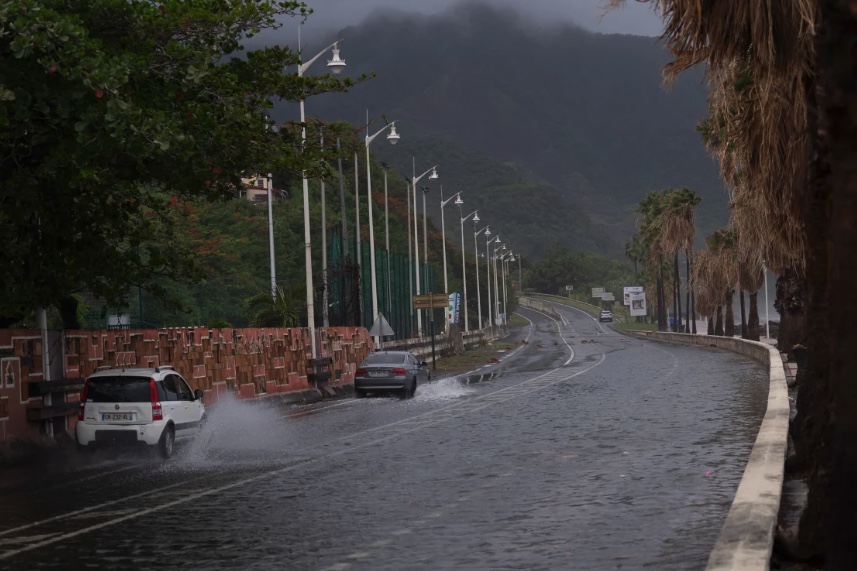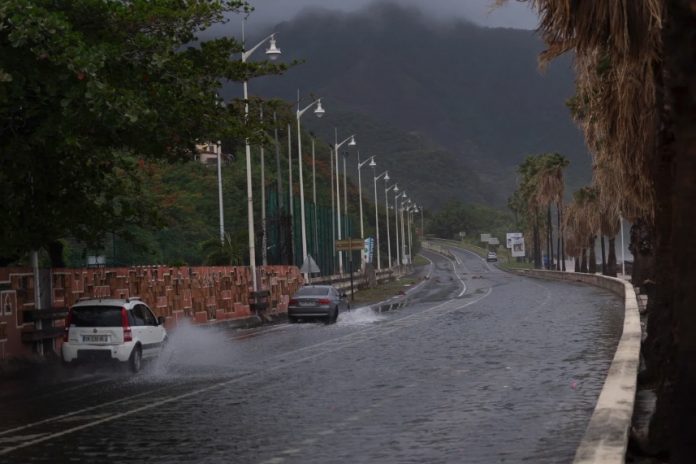พายุเฮอริเคนเออร์เนสโตทำให้เกิดฝนตกหนักและน้ำท่วมถึงเปอร์โตริโกเมื่อวันพุธ ส่งผลให้ไฟฟ้าดับหลายแสนคนในเปอร์โตริโกและหมู่เกาะเวอร์จิน ศูนย์เฮอริเคนแห่งชาติระบุด้วยความเร็วลมคงที่ 85 ไมล์ต่อชั่วโมง ซึ่งอยู่ห่างจากเบอร์มิวดาไปทางตะวันตกเฉียงใต้ประมาณ 635 ไมล์ในช่วงเช้าวันพฤหัสบดี เบอร์มิวดาอยู่ภายใต้คำเตือนพายุเฮอริเคน และอาจเผชิญกับลมพายุเฮอริเคน น้ำท่วมชายฝั่ง และฝนตกหนักสูงสุด 8 นิ้วภายในวันศุกร์ ในเปอร์โตริโก ครึ่งหนึ่งของเกาะไม่มีไฟฟ้าใช้เมื่อวันพุธ โดยที่ประชาชนราว 540,000 คนยังไม่มีไฟฟ้าใช้ในช่วงค่ำ ในหมู่เกาะเวอร์จินของสหรัฐอเมริกา ลูกค้าเกือบ 28,000 รายไม่มีไฟฟ้าใช้
คำเตือนน้ำท่วมยังคงมีอยู่ทางตอนเหนือของเปอร์โตริโกในเย็นวันพุธ เนื่องจากฝนตกหนักทำให้แม่น้ำล้น ขัดขวางการกรองน้ำ และทำให้ลูกค้ากว่า 120,000 รายไม่มีน้ำดื่ม แม้ว่าพายุเฮอริเคนเออร์เนสโตจะเคลื่อนเข้าสู่มหาสมุทรแอตแลนติก แต่ผลกระทบของมันยังคงสัมผัสได้ทั่วทั้งทะเลแคริบเบียน คลื่นพายุทำให้ระดับน้ำสูงขึ้น 1 ถึง 3 ฟุตตามแนวชายฝั่งตะวันออกของเปอร์โตริโก โดยคาดว่าจะมีคลื่นอันตรายตลอดสุดสัปดาห์ ผู้ว่าการเปโดร ปิแอร์ลุยซี ระดมกองกำลังพิทักษ์ชาติ ปิดโรงเรียนของรัฐ และเปิดศูนย์พักพิงเกือบ 80 แห่ง ชาวบ้านได้รับคำเตือนถึงปัญหาไฟฟ้าดับในวงกว้างที่อาจเกิดขึ้นได้ เนื่องจากโครงข่ายไฟฟ้าที่เปราะบางของเกาะ ซึ่งยังคงฟื้นตัวจากพายุเฮอริเคนมาเรีย LUMA Energy ได้จัดทีมงานเพื่อแก้ไขปัญหาไฟฟ้าขัดข้อง และเรียกร้องให้ผู้อยู่อาศัยรายงานไฟฟ้าดับ
เมื่อวันพุธ เออร์เนสโตเริ่มเคลื่อนตัวขึ้นเหนือสู่มหาสมุทรแอตแลนติกเปิด ซึ่งคาดว่าจะทวีความรุนแรงขึ้นเป็นพายุเฮอริเคนระดับ 3 ภายในปลายสัปดาห์นี้ พายุนี้อาจส่งผลกระทบต่อเบอร์มิวดาในสุดสัปดาห์นี้ โดยความรุนแรงขึ้นอยู่กับว่าพายุเคลื่อนผ่านไปยังเกาะนี้ใกล้แค่ไหน หากเออร์เนสโตเข้ามาจากทางตะวันตก เบอร์มิวดาจะเผชิญกับฝนและลมที่แรงขึ้น ถ้าอยู่ทางทิศตะวันออกผลกระทบก็อาจจะรุนแรงน้อยลง เออร์เนสโตจะมีผลกระทบสำคัญเหนือมหาสมุทรแอตแลนติกที่เปิดกว้างด้วยแรงหนุนจากน้ำทะเลอุ่นและลมรบกวนเพียงเล็กน้อย แม้ว่าจะไม่ก่อให้เกิดภัยคุกคามโดยตรงต่อแผ่นดินใหญ่ของสหรัฐฯ แต่ก็จะนำมาซึ่งสภาพชายหาดที่เป็นอันตรายตามแนวชายฝั่งทะเลตะวันออก คาดว่าจะไม่มีระบบเขตร้อนอื่นๆ ในมหาสมุทรแอตแลนติกจนถึงต้นสัปดาห์หน้า แต่คาดว่าจะมีเหตุการณ์เพิ่มขึ้นในปลายเดือนสิงหาคมถึงเดือนกันยายน
Hurricane Ernesto has cut power to half of Puerto Rico and is gaining strength as it moves toward Bermuda.

Hurricane Ernesto brought heavy rainfall and flooding to Puerto Rico on Wednesday, knocking out power to hundreds of thousands in Puerto Rico and the Virgin Islands. With sustained winds of 85 mph, the Category 1 hurricane was about 635 miles southwest of Bermuda early Thursday, according to the National Hurricane Center. Bermuda is under a hurricane warning and could experience hurricane-force winds, coastal flooding, and up to 8 inches of rain by Friday. In Puerto Rico, half the island lost power at some point on Wednesday, with around 540,000 still without electricity by nightfall. In the US Virgin Islands, nearly 28,000 customers were without power.
Flood warnings remained in place for northern Puerto Rico on Wednesday evening as heavy rainfall caused rivers to overflow, disrupting water filtration and leaving over 120,000 customers without drinking water. Although Hurricane Ernesto moved into the Atlantic, its effects were still felt across the Caribbean. Storm surges raised water levels by 1 to 3 feet along Puerto Rico’s eastern coast, with dangerous swells expected through the weekend. Governor Pedro Pierluisi mobilised the National Guard, closed public schools, and opened nearly 80 shelters. Residents were warned of possible widespread power outages due to the island’s fragile electrical grid, still recovering from Hurricane Maria. LUMA Energy has deployed crews to address outages and urged residents to report blackouts.
On Wednesday, Ernesto began moving north into the open Atlantic, where it is expected to strengthen into a Category 3 hurricane by late this week. The storm could impact Bermuda this weekend, with the severity depending on how close it passes to the island. If Ernesto approaches from the west, Bermuda will face stronger rain and wind; if it stays east, the effects may be less severe. Fueled by warm ocean waters and minimal disruptive winds, Ernesto will have significant impacts over the open Atlantic. While it doesn’t pose a direct threat to the U.S. mainland, it will bring dangerous beach conditions along the Eastern seaboard. No other tropical systems are expected in the Atlantic through early next week, but activity is expected to increase later in August and into September.
By CNN NEWS

















